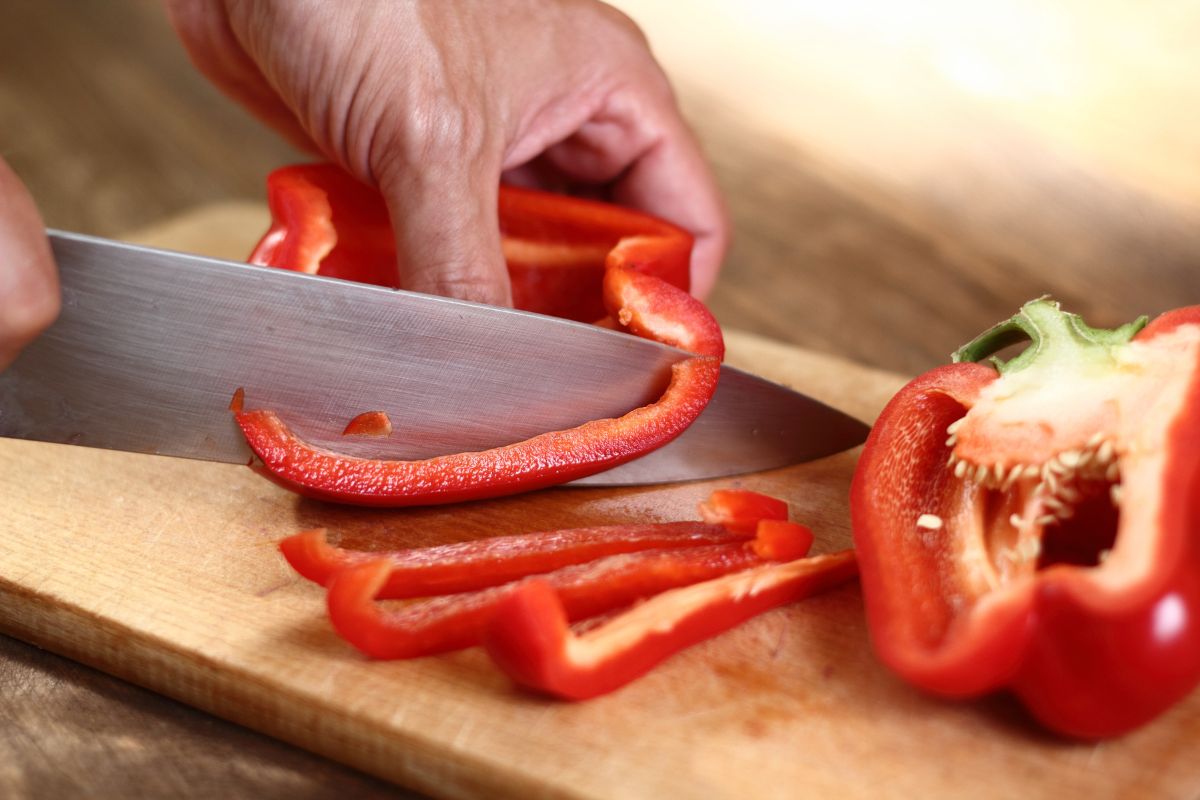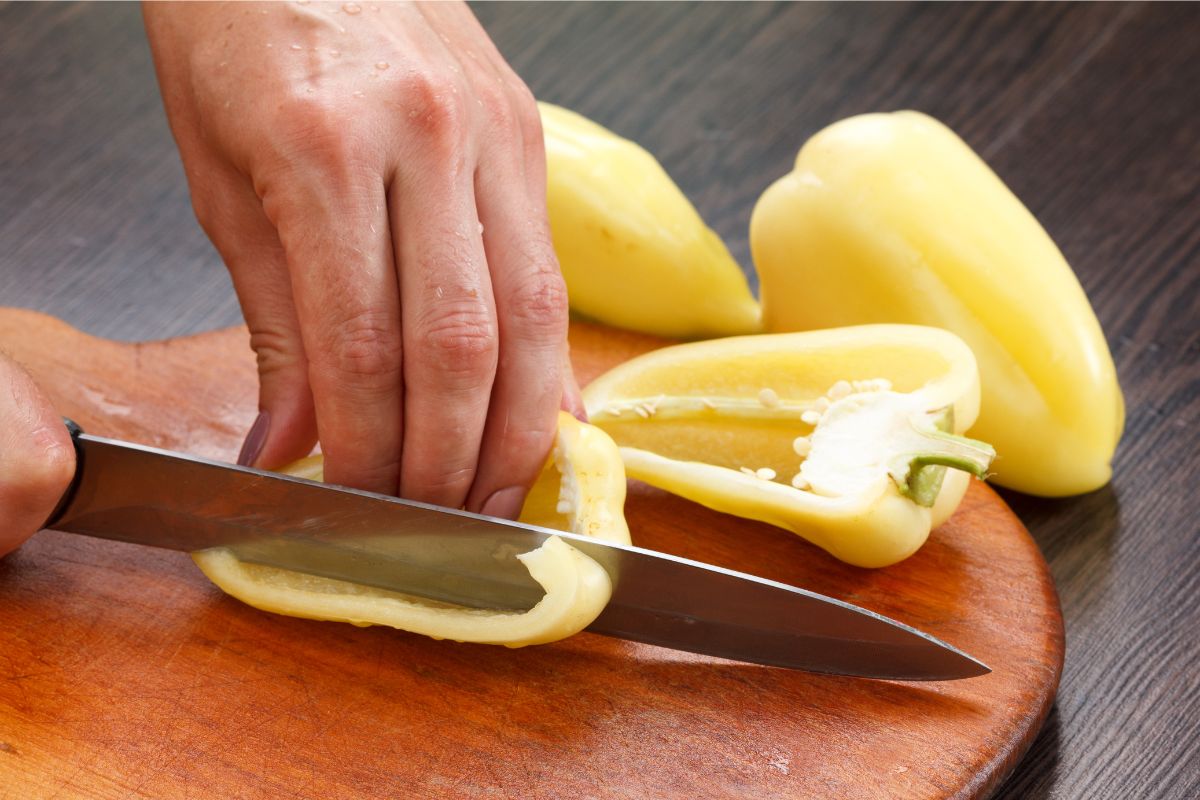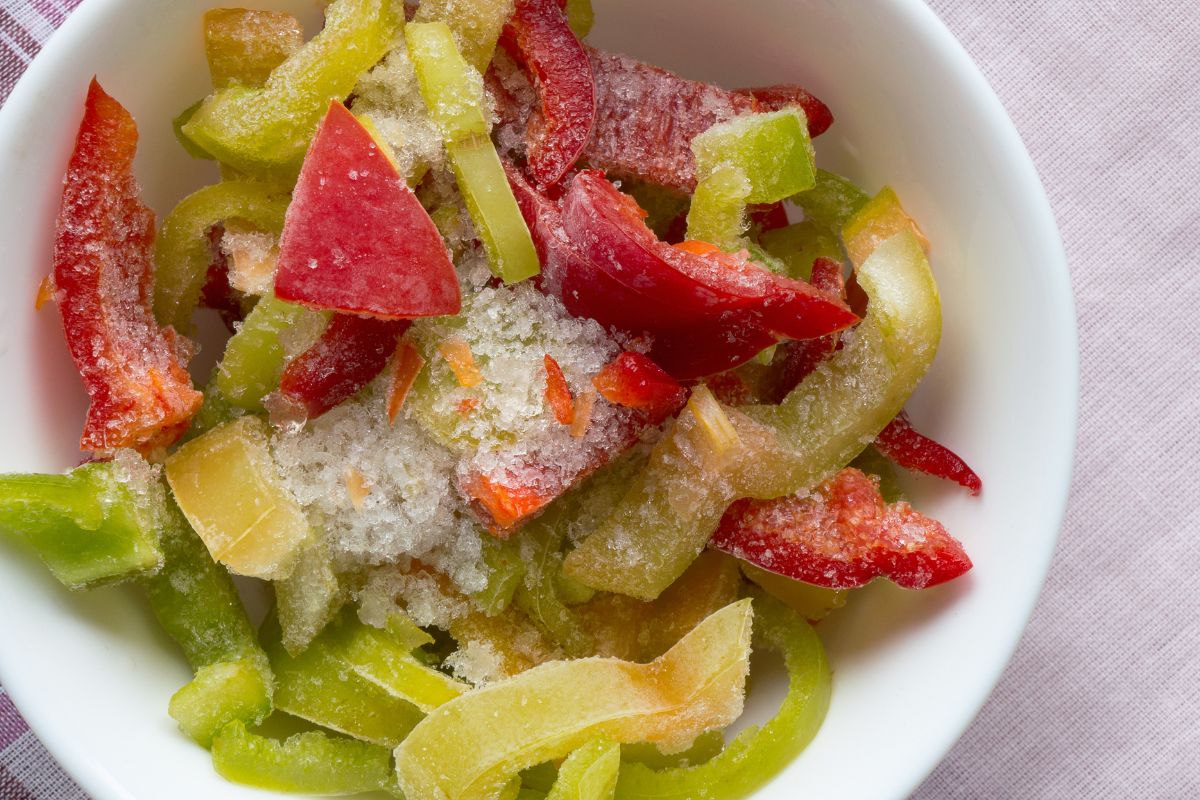The striking colorfulness of bell peppers (and, to be truthful, the rollercoaster of prices) can confuse a regular customer at the greens stall. And the moment the purchased peppers are on the kitchen table, so full of seeds and weirdly shaped, one suddenly realizes they have no idea how to cut a bell pepper.
Luckily, many people have asked the same question before, holding a knife and scared to carve their finger instead of a pepper. But cutting bell peppers can be easy, and the following tips may help encourage one to include them in the next cooking session.
What is Bell Peppers?
Biologically, bell pepper is a cultivar group of flowering plants, a part of Capsicum annum L. species from the family Solanaceae.
In simpler terms, bell pepper is a hollow vegetable with seeds, which usually grows from the flower.
Their colors – red, yellow, and green – make the biggest difference in bell peppers. Depending on the color, they have different nutritional values.
That’s why knowing how to cut a bell pepper can extract the most out of it.

The Different Uses of Bell Peppers
Bell peppers are indispensable ingredients in many world cuisines: Mexican, Italian, Indian, South East Asian, and many others. There, this vegetable (technically a fruit) comes in all shapes and forms when cooked.
Most households chop bell pepper in salads or use them as toppings for different meals. Raw bell peppers often go into salads, where their watery and crunchy flesh gives a refreshing sensation to the tongue.
But there are far more ways to use bell peppers, which allow one to release most of their value and appreciate the variety of tastes.
With green bell pepper, there is a variety of recipes. Due to its bitter taste, it is suitable for omelets, pan pizzas, and a topping for mild meals that need this bitterness for contrast.
Green pepper is an irreplaceable ingredient of Cajun and Creole cuisine. Being a part of “The Trinity” of ingredients along with onions and celery, green bell pepper reinforces the taste of the meal, adding a tickling bitterness to it.
Examples of Cajun & Creole meals with green bell peppers include chicken sausage gumbo, jambalaya, shrimp etouffee, and rice with red beans.
However, in some dishes, the choice of color does not matter. Stuffed bell peppers taste delicious regardless of it. To be more precise, each colored bell pepper creates a unique palette of taste depending on the properties the color tells about.
Luckily, the number of recipes for stuffed bell peppers is above and beyond. For someone who just started exploring, mac&cheese stuffed bells will be perfect; and for someone who’s more advanced, the names like quiche or Mediterranean stuffed bell peppers should cause goosebumps of gastronomical thrill.
The beauty of stuffed bell peppers is a variety of ingredients one can experiment with. For example, vegans can enjoy rice and mushroom stuffing in yellow or red bell peppers – the result is a savory and juicy meal, with bell peppers adding a coat of sweetness to it.
As for meat lovers out there – Mexican stuffed peppers may do the magic. The recipe includes meat (turkey or chicken are the most common), brown rice, and mouth-watering strands of melted cheese; all ingredients together – these stuffed peppers are the fireworks of health!
There is even a recipe for fish enthusiasts, so no one’s left behind. The recipe is relatively easy – the stuffing is tuna salad with cheese topping. And yet it is so delicious!
And the beauty of all these recipes is the flavor that different bell peppers bring to the table. Depending on one’s preferences and the type of bell peppers, the recipes can adjust to have a more bitter, sweet, or mild taste, so everyone is happy.
Bell peppers are definitely more versatile than being stuffed. No article on these life-saving vegetables (or fruits) can omit fajitas.
The original fajitas recipe involves sauteed peppers and onions, used as a complement for satiating chicken meat. And despite many variations – use of black beans, corn, or tomato avocado salad – bell pepper always stays.
Finally, bell peppers can easily compete for the position of first-class compliment. In pasta, red bell peppers add a special taste, especially when they are raw or slightly cooked. This matches summer heat when lighter meals feel better for the stomach.
Diced peppers work greatly with fried meals. Rice dishes gain a different taste with added bell pepper. Capsicum rice is a simple yet delicious meal one can cook in a pot or stovetop.
For something more complex, one can try cooking Shakshuka – “a haphazard mixture” from Arabic. Bell peppers can be a great addition to this meal of eggs, tomatoes, cheese, and parsley.
To combine these ingredients in one delicious creation, one can try cooking pepper sauce with roasted red bell peppers. As a result – a steamy and savory meal for a whole family.
The Difference in Bell Peppers
As one could notice from the previous sections, different bell peppers – specifically their colors – give a different taste to the meal.
The reason why the color – red, orange, yellow, or green – mattered was that it stands for the degree of pepper’s ripening. And as it seasoned, the taste changed from bitter to sweet. The longer a bell pepper stays on the vine, the riper – and thus sweeter – it becomes.
The degree of ripening also influences the product’s shelf life. Green peppers can stay edible for longer, but they have far fewer nutrients than other, more mature peppers.
Maturity is also why green bell peppers are cheaper than red or yellow, which stay on the vine for a longer time and thus have a shorter shelf life left.
Now that the basics are covered, the problem comes up the second bell peppers are clean and on the cutting board. How do you cut bell pepper, so the vegetables preserve all the nutrients?

How to Cut a Bell Pepper
In this section, one can finally learn how to properly cut bell pepper. Learning the secrets to perfectly diced peppers will save time in the kitchen and make dishes richer in nutrients.
Cutting Peppers Into Rings
Start with putting the washed pepper on its side. Using a sharp knife, cut off about a half an inch piece from the stem end and repeat the same with the bottom.
Remove the core by inserting the knife in a circular motion inside the pepper. Take out the core. From a side position, slice the pepper into thin rings.
There are many ways to use pepper rings in cooking, from crudite plates to sandwiches. For someone who likes spicy meals, pepper rings are perfect for chili. For healthy eaters, fried eggs in pepper rings is a quick and nutritious breakfast. They also work as a movie snack, with bacon-wrapped bell pepper rings completing the atmosphere.
Slicing Peppers
For sliced bell peppers, the procedure is similar. Slicing starts with removing half an inch off the pepper’s top and bottom.
Next, make two vertical cuts through the pepper. Open it and gently remove the core with a knife to not scatter the seeds.
Then, put the pepper halves with the skin facing down because it’s easier to cut the pepper’s flesh. Take a sharp knife to slice thin strips or chop bell pepper, depending on the size you need.
As the pepper is cut properly, use the strips in salads, and add them to crudité plates. Aside from eating fresh peppers, one can sauté them to later use in soups and stews. Read our article and find out Our BEST Recipe for Escarole Soup.
How to Cut a Bell Pepper for Fajitas
It is important to remember that the time for stewing or sautéing bell peppers often depends on the size of the slice.
For example, knowing how to cut a bell pepper for fajitas, specifically which size to choose, can cause it to cook longer or faster. The thicker the slice, the longer it will take to cook.
The optimal size to cut a bell pepper for fajitas is ¼-inch strips. This way, they will soften just enough without turning soggy.
Dicing Bell Peppers
Questions on how to dice a bell pepper are no less frequent. Again, when cutting up bell peppers into large or small dice, start by cutting half an inch off the top and bottom.
Then, make two vertical cuts in the flesh, identical to those when slicing the pepper. Open the vegetable and remove the core with a knife. If using the knife is inconvenient, one can also try and discard the core bare-handedly, gently.
Lay the pepper halves with the flesh side up, and cut them into strips. The width depends on the dice size one needs.
When the strips are ready, rotate them by 90 degrees and do the same procedure – cut through strips to get dice. Cut more widely or thinly to regulate the dice size. For consistent dice, remove the ends of the pepper, so it’s more aesthetically pleasing.
Diced bell pepper is a perfect addition to many recipes. They mix well with egg dishes, so it’s an excellent opportunity to experiment with breakfast omelets. Like sliced peppers, the dice is suitable for soups or stews; Creole cuisine is a great example – no wonder it’s so delicious.
Can You Freeze Cut Bell Peppers?
It is absolutely possible to freeze-cut bell peppers. It is a convenient way to save time for cooking (especially if one prefers prep meals), as well as most nutrients through freezing.
Interestingly, bell peppers are easy to freeze, either chopped, sliced, or even whole peppers. There are a few secrets on how to do it properly.
First, the peppers must be tender and crisp because the second frozen peppers are out of the freezer. They can turn soggy. So putting a flabby pepper into the freezer is already a bad idea.
Second, one has to wash peppers and scrub them gently. The next step is removing stems, seeds, and a membrane. One can do it by cutting the washed peppers in half and cleaning them out with a melon baller or a spoon.
Once peppers are clean, one has to cut them into strips, slices, or dice them, depending on the taste.
Before the final freezing, it is better to freeze the chopped pieces of peppers on a clean cookie sheet for an hour (or until they are frozen). The point of doing that is to prevent the pieces from freezing to each other once in a freezer bag. After all the steps, the final stage is to put the plastic food bags in the freezer and use the pepper in cooking.
An important note before sealing the begs – getting rid of excess air is a must.
If there are no plastic food bags at home, one can store chopped bell peppers in freezer paper, plastic containers (with the snowflake symbol), and heavy-duty aluminum foil.
To store frozen bell pepper properly, the freezer temperature should not exceed 0 degrees Fahrenheit. As for the “expiration date,” it extends from 6 to 8 months for best quality.

Is Organic Bell Peppers Worth it?
The boom in the popularity of organic fruits and vegetables in the last few years seems like a great thing until one sees the prices. Unfortunately, growing organic fruit and greens are expensive, which causes high prices.
Organic is synonymous with pesticide-free. Bell peppers tend to absorb more pesticide residue than other vegetables. So, if bell peppers are regular in one’s kitchen, it is better to choose organic veggies.
However, when it comes to taste and nutrition, there is no difference between organic and non-organic bell peppers.
So, it is really an individual choice.
Tips on Choosing the Best Bell Peppers
There are a few hacks on how to choose ripe bell peppers.
- Take a close look at the color. A ripe bell pepper will have a deep color, either green, yellow, or red. It is even better if a pepper has a glossy sheen.
- Avoid bruises, blemishes, or softness because they point to damage and the rotting process.
- A gentle squeeze should give a firm sensation. It means the pepper is fresh.
- Fresh bell pepper is heavy and full of water.
- Keeping bell peppers well hydrated will allow them to stay fresh for up to 10 days. So, putting a damp cloth next to these vegetables will help.
Final Verdict
Cutting bell peppers may be a tricky thing, depending on the meal. Knowing how to chop peppers can help save all nutrients and taste. It is essential to start with ripe bell peppers, so cutting and cooking will be much easier, and the taste – just perfect.
There’s no need to worry too much about chopping bell peppers. Hopefully, the tips in this article will encourage one to cook something tasty for the next lunch without overstressing oneself.

Community of passionate writers and content creators who share a love for Italian heritage, culture, travel, food, and the Italian-American community. Our mission is to celebrate Italy’s rich history and traditions and connect with others who share the same passion.

